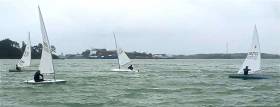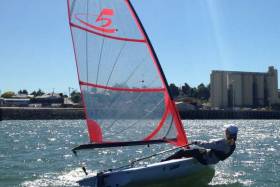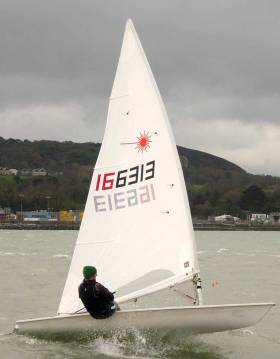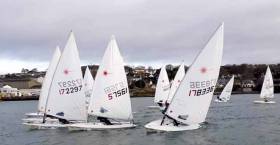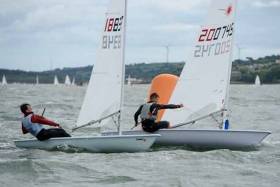Displaying items by tag: Laser
Irish Laser Sailor Finn Lynch Contests 2019 World Cup Series in Miami
The National Yacht Club's Laser sailor Finn Lynch is the only Irish Olympic trialist for Tokyo 2020 competing in tomorrow's 2019 World Cup Series Miami, held out of Coconut Grove from 29 to 3 February. The first big event of 2019 will see nine defending champions return to Biscayne Bay determined to defend their titles.
2019 marks the 30th edition of an Olympic sailing regatta in Miami and, with 650 sailors from 60 nations registered to race across ten events, it’s expected to be another strong year of competition.
Lynch, who has yet to make the country standard for Tokyo will be aiming to beat his own past achievements in Florida. Last January proved a tough but valuable testing ground for the then 21–year–old, who won gold at the 2014 U19 World Championships. Lynch ended up 32nd in his 70–boat fleet overall after nine races sailed.
Of the 2018 Miami gold medallists, Giles Scott (GBR) is the only athlete not competing this year. Across the ten events, there are 34 Olympic medallists racing alongside numerous World and World Cup podium finishers, and the best sailors will be vying for a World Cup medal as the race to Tokyo 2020 continues.
Australia’s Jason Waterhouse and Lisa Darmanin will come into Miami as favourites in the Nacra 17 after securing gold at the first round of the Hempel World Cup Series in Enoshima, Japan last September.
Waterhouse and Darmanin overthrew Ruggero Tita and Caterina Banti (ITA) in the Medal Race to claim a hard-earned title - but exactly one year ago, the competition was slightly less stressful for the Aussies. Racing on the Biscayne Bay waters in 2018, Waterhouse and Darmanin controlled the fleet all week long and simply needed to finish the Medal Race to secure gold. They did that with ease and are back to defend their title.
Santiago Lange and Cecilia Carranza Saroli (ARG) and Thomas Zajac and Barbara Matz (AUT) joined them on the podium in 2018 and also return this year.
Further contenders in the 31-boat Nacra 17 fleet include Samuel Albrecht and Gabriela Nicolino de Sá (BRA), Iker Martinez and Olga Maslivets (ESP), John Gimson and Anna Burnet (GBR) and Bora Gulari and Louisa Chafee (USA).
Racing is scheduled to commence on Tuesday 29 January and run through to Sunday 3 February. More on the event site here
Wild Sailing for Monkstown Lasers in Cork Harbour
Saturday, January 26th saw tough conditions on Monkstown Bay for day three of the Monkstown Laser Frostbite League sponsored by CH Marine.
The third day of the Monkstown Laser league was a story worth telling. The skies appeared at daybreak revealing black clouds scuttering at tremendous speed across Cork Harbour. Halyards were slapping against the masts and white horses were beginning to form in the bay. A windy day was in store for the competitors.
An ominous forecast showed winds gusting up to 37 knots. With the forecast in mind, the sailors arrived at the Sand Quay in time for a short briefing held at 9:30 am. Deciding the conditions were manageable, the toughened sailors enthusiastically rigged their lasers. The howling wind threatened to blow the boats over but this did not stop the sailors from launching into the wild conditions on Monkstown Bay.
"The howling wind threatened to blow the boats over but this did not stop the sailors from launching into the wild conditions"
Race Officer Alan Fehily called for a windward/leeward course situated at the entrance of Monkstown creek. The residents of Alta Terrace had a view of the sailors battling their way out to the course to be on time for the 10:15 start.
Some sailors stayed ashore having decided the conditions were too rough; this left eight sailors fighting for position on the start line for the first race. The competitors got off the line cleanly and began the first beat to the windward mark. It was a hard fought battle between MBSC sailors Ronan Kenneally, and series leader Charles Dwyer. Kenneally held his lead for the majority of the race all the while getting heavily contested by Dwyer. Kenneally crossed the finish line, securing first. Dwyer finished close behind. MBSC’s Chris Bateman finished third.
In the radial fleet, Robert McGarvey of Innascarra Sailing Club was the only radial sailor to brave the conditions. This saw him take first place, while still contesting the standard rig sailors.
The second race was no less difficult with the tide beginning to strengthen. The sailors had to pick their path carefully for the first upwind leg. The first to round the windward mark was MBSC’s William O’Brien. Fending off MBSC’s Brendan Dwyer and Chris Bateman, he held onto his lead for the first downwind leg. A tight battle on the final lap saw Ronan Kenneally slip through, to contest with O’Brien and Dwyer. The first to finish was Bateman and in second place was Kenneally. Brendan Dwyer took third position.
Sailing the radial rig, Robert McGarvey was mixing it in with the standard fleet.
The third and final race of the day was a race that the sailors will never forget. The race was started quickly and the sailors got off the line cleanly. It was a close fight between Charles Dwyer, Ronan Kenneally and Rob Howe. The wind began to increase and the leading sailors were the first to notice. All of a sudden the wind strengthened even more. Gusts of thirty knots were blowing across the water, lifting the spray off the tops of the waves. Masts were bent double, and the lasers were flying downwind with their sailors hanging on for their lives. Kenneally attempted a gybe, immediately capsizing and letting Howe through. Heavy weather specialist Charles Dwyer blasted away from the fleet, his boat throwing several feet of spray into the air. The leeward mark saw gusts of thirty-five knots hitting the Lasers. It was a race of survival, and the sailors were doing everything that could be done to stay upright. Charles Dwyer took first place, having held a comfortable lead. In second place was Rob Howe. In third place was Ronan Kenneally, having recovered his position well.
"The leeward mark saw gusts of thirty-five knots hitting the Lasers"
With a feeling of relief, the sailors went ashore. Sandwiches and hot drinks were waiting in the Bosun for the competitors where they could relax after a hard day's work.
International Laser Class: "No Plans to Replace or Remove Any Of Its Existing Classes"
The International Laser Class says it has no plans to replace or remove any of its existing classes in response to recent media speculation on the future direction of the Olympic class boat plus a statement on social media from builder Laser Performance that it will introduce the ARC in May 2019, 'a contemporary racing rig and sail for Laser and Laser Radial that broadens the sailor weight range and increases overall performance'.
The Laser dinghy is the world and Ireland’s most popular and competitive boat with a vibrant scene across Ireland, attracting sailors across a wide age range. For example, 70 Lasers are entered for the DMYC Frostbite Series at Dun Laoghaire this month with other leagues currently underway in Cork and Howth.
In a statement, the ILCA says it is aware that photos and videos of some developmental rigs for use with the Laser hull as well as portions of a recent media release from Laser Performance have led to quite a bit of questioning, speculation, and information (as well as misinformation) swirling around the internet.
ILCA would like to share with our members the class perspective on some of these matters.
First, ILCA has no plans to replace or remove any of our existing classes. The 4.7, Radial and Standard classes will continue as always with controlled, incremental evolution and development aimed at improving longevity, increasing the ease of use and reducing the cost of ownership.
Second, any new rigs that are in development are not proposed for inclusion in the Olympic reevaluation or sea trials. It is the existing Standard and Radial rigs that ILCA is working to have retained for the Olympic Games. The one proposed change at this time is a new composite Radial lower mast that is in development with an introduction planned so as not to conflict with the 2020 Olympics. The composite Radial lower mast is intended to eliminate any permanent bending issues seen in some aluminum masts and therefore reduce the cost of owning, maintaining and racing the Laser Radial.
Third, consistent with ILCA’s past practice, any new rigs for the Laser hull will only become class legal equipment after thorough testing and widespread evaluation in conjunction with the ILCA Technical Officer, the ILCA Technical and Measurement Committee and with the approval of World Sailing.
As background to our current situation, there have been various development projects for alternate rigs for the Laser hull for decades. Indeed, both the Laser Radial and Laser 4.7 rigs were developed at different times to extend the range of sailors who could enjoyably sail and compete on a Laser hull. Those classes rose from an experimental introduction to become very successful worldwide one-design racing classes, with the Laser Radial eventually being selected as Olympic equipment for the women’s one-person dinghy event beginning in 2008.
Four years ago, Performance Sailcraft Australia brought to the ILCA World Council information and video about new rig ideas they were working on in conjunction with some local sailing enthusiasts. They had gone through several design and testing iterations and felt they had something that showed promise. That concept was then brought to the World Council to see whether there might be any interest from the ILCA in furthering or adopting such a rig for use on the “Laser” hull. The World Council thought the idea had potential and encouraged further development. It was thought that a rig of this type might particularly appeal to the group of sailors that were transitioning out of the Optimist.
While many young sailors in Europe transition from the Optimist directly into the 4.7 rig, in other parts of the world this does not occur as regularly and we see sailors migrate into other classes, or try to jump directly into the Radial, which can be a difficult transition if the sailors are not yet physically capable of handling the rig in the prevailing conditions. Worse yet, many young people simply quit sailing if they find there is no suitable boat past the Optimist available.
With this context, the ILCA World Council therefore determined it worthwhile to see if a new rig could be developed that would facilitate a smoother transition from the Optimist into the Laser family. It was also believed that a new rig might potentially serve as a viable racing platform for smaller adults, for whom the Radial is too large and where the 4.7 hasn’t gained traction as a racing class.
Initial tests of this new rig (with the working name “C5”) have been positive and development has now reached the point where it would be useful to deploy a reasonable number of sample rigs “into the field” as a test to see how they perform in racing conditions in active fleets. The goal would be to get some feedback on the viability of the rig in competition and any difficulties or problems that might potentially arise so that these issues could be addressed before any kind of official adoption by the class. Performance Sailcraft Japan, which has long been championing the idea of a way to make the Laser more viable for lighter weight sailors, has stepped up to serve as the lead builder on the introduction of the “C5” test rigs.
It should be noted that this whole project predates by quite some time the current Olympic reevaluation process and is NOT a response to the announcement of sea trials or the review of the Laser as Olympic Equipment. As stated previously, it is the existing Standard and Radial rigs that ILCA is working to have retained for the Olympics. The only thing new for the Laser Olympic classes at this stage is the proposed addition of a composite Radial lower mast. It should also be noted that all the builders, including Laser Performance, and Performance Sailcraft Japan, were in attendance at the relevant World Council and Technical Committee meetings over the past four years and have been fully aware of the “C5” development project.
In addition to discussions about the “C5” project at the ILCA World Council meeting in November 2018, an announcement was made by Laser Performance that they had recently begun working on their own new rig for use with the Laser hull. They indicated that the project was not yet to the point where they could share information about the design but wanted to keep the class apprised that there was an ongoing development project. It was explained that more detailed information would be provided if or when the project looked viable and that the rig (or rigs) could be used effectively on the Laser hull. It now appears that Laser Performance is calling their new rig the “ARC.” Depending on the progress of the ARC rig, ILCA may be able to evaluate both the ARC and the C5 approaches before moving forward with the process of adopting a new rig as class legal equipment.
So, although there are several designs currently being developed by different builders, ILCA’s intention for adopting any new rig would be to attract a group of sailors to the “Laser” family that we are currently not capturing. Of course, we recognize that there will be future development on these projects and ILCA will continue to monitor and work with all builders as we have in the past.
"it is a sailor’s ability, and not the amount of money spent on equipment, that determines who wins a race"
Obviously, ILCA can’t say whether any of these new rigs would ultimately prove to be successful. Success or failure would be up to the sailors – who could decide whether or not to purchase rigs and sail in a new class or choose one of the three existing classes (Standard, Radial, 4.7). To be certain, IF the class adopts such a rig, ILCA would work to ensure a strict one-design approach is maintained so that, as always, it is a sailor’s ability, and not the amount of money spent on equipment, that determines who wins a race.
Finally, ILCA fully understands and appreciates that perhaps the best feature of sailing a Laser is the opportunity to race one-design, at low cost, in large fleets, with a high level of sailing skill. This is what we strive to maintain for our members and what we will continue to focus on as a class association.
Daragh Kelleher Shows Superb Speed in Big Laser Turnout for Howth Yacht Club Spring Series
New Years’ Resolutions and a fresh start for 2019 led to our biggest Laser turnout of the winter so far in Howth Yacht Club. A favourable forecast also helped. Conditions were perfect for Laser racing, with the wind starting off from the West at 9 knots and moved slowly right all morning, picking up to 22 knots by the end of the second race. 26 boats launched, one of biggest fleets of the season so far, including good representation of Radials and 4.7s. West to North West is the ideal direction for racing in Howth Sound, with relatively flat water and very little land influence over the breeze. We get steady oscillating shifts most of the time. However, yesterday was particularly tricky, with the wind veering and the ebbing spring tide flowing down the beat. The fleet was faced with the decision on whether to go left for the slacker water or right to maximise the benefit from the wind shift. Most of the fleet decided to play the shifts up the middle, protecting the right, but trying to stay out of the tide as much as possible.
The fleet was tightly bunched, but after a late start, Daragh Kelleher made the correct call, and came screaming in from the left corner to lead at the first mark. Dave Quinn, Eoin Delap, Stephen Quinn and Conor Murphy were all tightly bunched behind. Daragh led for the first lap, and maintained his lead for the rest of the race, despite a risky second beat where he attempted to avoid the tide on the island side of the course (much to the amusement of sailors after racing!). Dave Quinn finished second, with Ronan Wallace recovering well from a bad first beat to finish third.
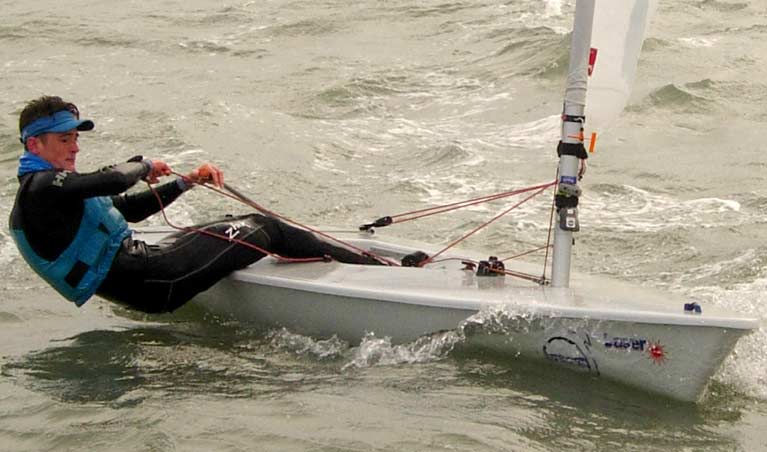 Tom Fox
Tom Fox
The second race was windier, and most sailors decided staying out of the tide was far more important than any shifts so boat speed became paramount. After a General Recall, the fleet got away in a very tight start. Daragh Kelleher, Ronan Wallace and Dan Oconnell all rounded the first weather mark together and racing was very close throughout the Olympic format Course. Daragh was able to maintain a lead on the second beat and keep Dan behind him to the finish. Ronan Wallace finished third. It was great to see a few more Radials and 4.7’s out. Tom Fox won both races again, and continues to dominate, even putting plenty of the Standard Rigs under pressure each race. Sophie Kilmartin won both races in the 4.7 rig also.
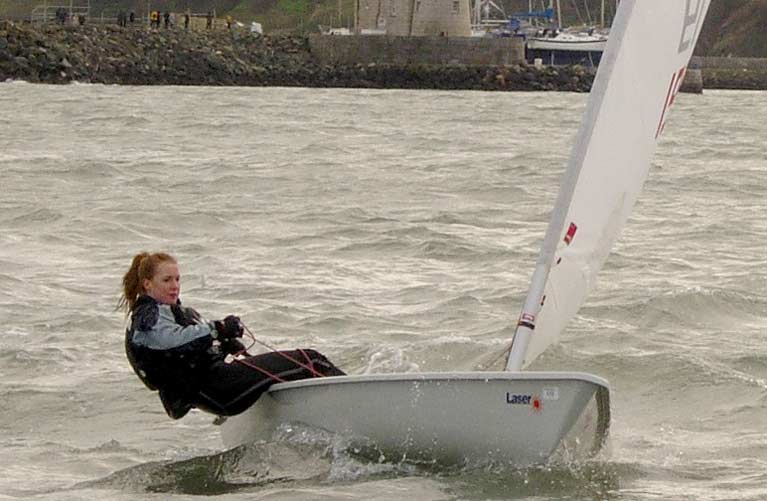 Orlagh Thompson
Orlagh Thompson
Monkstown's Charles Dwyer Leads CH Marine Laser League on Cork Harbour
Laser sailors gathered on Monkstown Bay for Day Two of the Monkstown Bay Sailing Club Laser Frostbite League, sponsored by CH Marine writes Chris Bateman.
The morning dawned with a thick dreary fog laying over every inch of Cork Harbour. A beautiful sunrise cheered up the scene by illuminating the fog and casting an icy golden look over Monkstown Bay. Scroll down for photo gallery by Bob Bateman.
 There was an early fog in Monkstown Bay for the Laser racing Photo: Bob Bateman
There was an early fog in Monkstown Bay for the Laser racing Photo: Bob Bateman
Not a breath of wind could be felt and as the fog lifted slowly, the bay was revealed to be still as a mill pond. The sailors were not put off by the conditions and onlookers could see the competitors taking ice off their boats and eagerly raising sails.
 Monkstown Bay was like a mill pond Photo: Bob Bateman
Monkstown Bay was like a mill pond Photo: Bob Bateman
A cold light wind filled in from the North West, blowing the rest of the fog away just in time as the sailors launched their boats from the Sandquay.

Race officer Alan Fehily set a windward/leeward course at the mouth of Monkstown Creek with time to spare for the 10:15 start.
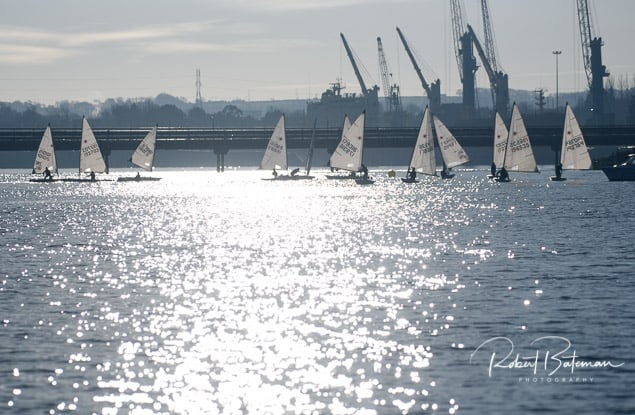
The start sequence began for the first race and fourteen laser sailors scrambled into position on the start line. The sailors got away cleanly and it was a drag race out to the favoured left side of the course. It was a close battle between MBSC sailors Ronan Kenneally, Alex Barry and your correspondent. The light winds made for heated racing with tacking and gybing duels occurring throughout the race. Alex Barry decided to switch from the smaller radial to the standard rig and was proving to be very fast in the light conditions. Barry held first position on the downwind leg but capsized before the leeward mark. Kenneally then took the lead and went on to win the first race. Bateman finished second, Alex Barry finishing third.
In the Radial fleet, MBSC’s Harry Pritchard revelled in the light conditions, winning the first race with a comfortable lead.
The second race proved difficult with the wind easing off to a steady five knots. The flood tide was becoming increasingly prominent on the course. Alex Barry poked out ahead of the fleet, rounding the windward mark in first. He was followed close behind in second by Inniscarra sailor James Long. Barry held on to his lead while steadily gaining distance on the fleet. All the action was behind him, with most of the fleet debating who has water at the leeward mark. In the end, Alex Barry took first position, this writer second and James Long in third.
In the Radial fleet, Harry Pritchard used local knowledge to get around the course the fastest way, and took first place.
Race three was more challenging than the rest. It was a battle between Alex Barry, Ronan Kenneally and Charles Dwyer. The wind slowly died away leaving the sailors becalmed. Pockets of breeze occasionally would hit the water. The course was shortened and the competitors finished the race at the windward mark. Alex Barry took his second win of the day. Ronan Kenneally finished second. Charles Dwyer who was on great form on the first day struggled in the lighter air but still managed to finish third, right behind Kenneally.
RCYC’s Sophie Crosbie took first place in the Radial fleet.
The Laser sailors then sailed ashore and were on dry land by 12 O’Clock. Hot drinks and sandwiches were in order, so the sailors gathered in Napoli to talk about what was another successful days racing.
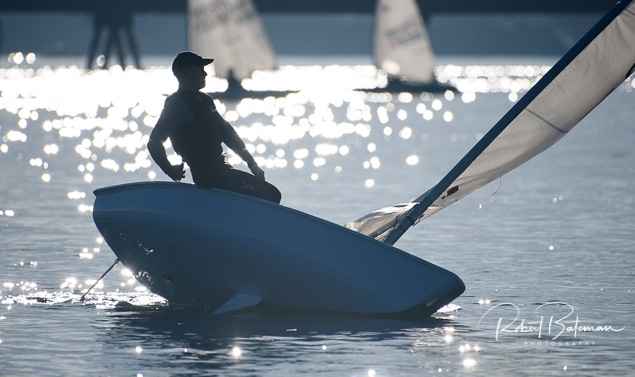
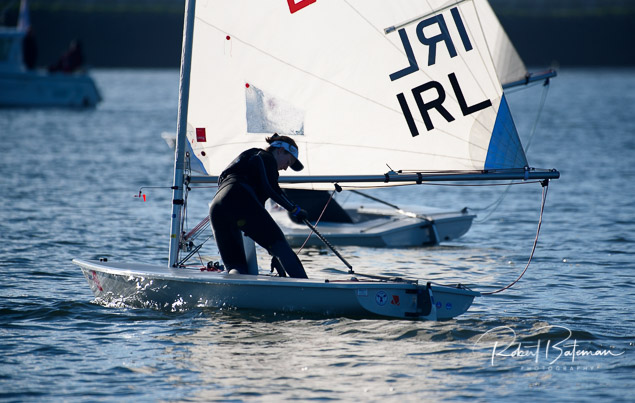
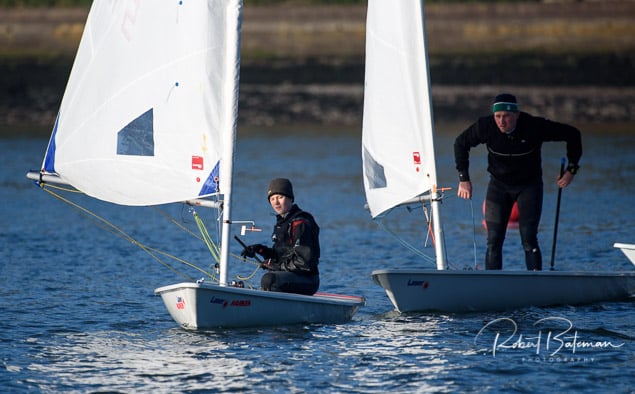


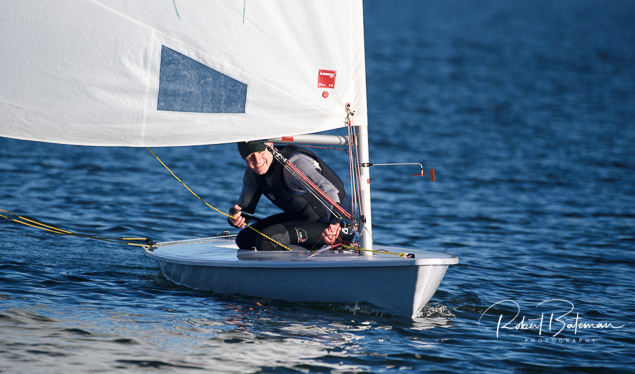
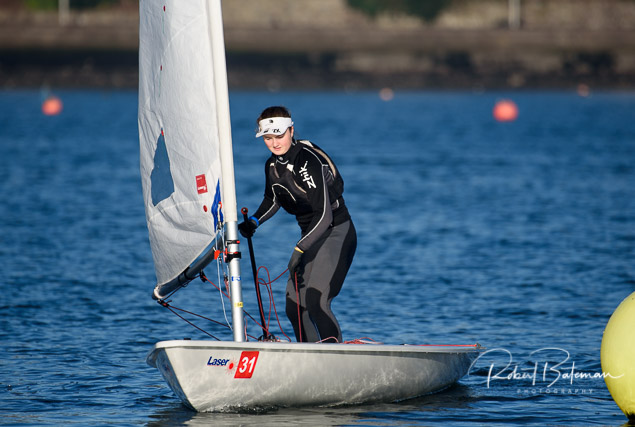
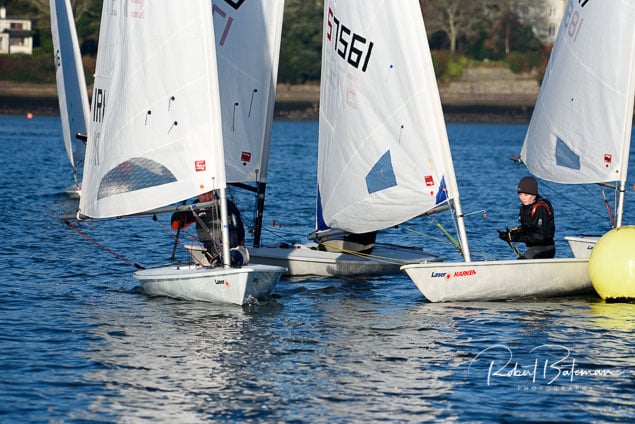
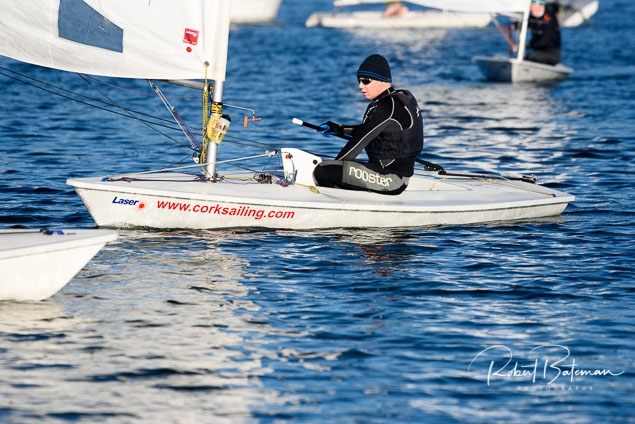
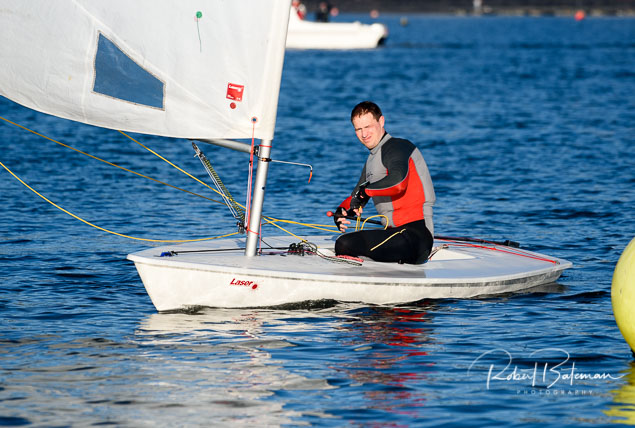

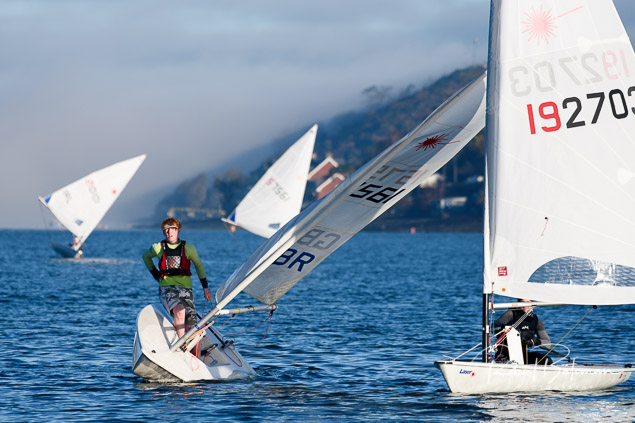
Results are downloadable below
Dwyer Holds off Durcan to Win First Laser Race of Monkstown League
Saturday, January 12 was the kick off of the Monkstown Laser Frostbite League organised by the Laser sailors of Monkstown Bay Sailing Club in Cork Harbour writes Chris Bateman.
The morning was promising with patches of blue sky and a cool breeze blowing over DeVesci Place from the west. The threat of the ice-cold sea was not enough to put the eager laser sailors off from taking to the waters of Monkstown Bay.
It was an early start for the competitors. Sails could be seen on the Sandquay as early as nine o’clock. Race Officer Alan Fehily cast off in good time to set a windward/leeward course off Blackpoint, in perfect time for the 10:15 start.
The first day of the league attracted an excellent entry of 15 boats, 12 of which were standard rig lasers. The three radial entrants were welcome participants; inclusion of the radial rig is a new departure for the league.
The start sequence began for the first race, the sailors jostling for position on the line. It was an all-in start and the sailors got away cleanly to begin the first upwind leg. The competitors had been instructed to do three rounds of the course. Each upwind leg was a struggle against the strong ebb tide that Monkstown Bay is well known for. It was a battle between RCYC’s Johnny Durcan, and MBSC’s Charles Dwyer. Durcan held the lead until he was safely across the finish line, securing first. Dwyer finished just behind, putting pressure on the laser ace. Ronan Kenneally of MBSC finished third in hot pursuit.
In the radial fleet, MBSC’s Alex Barry was the first to cross the finish line after a tough race.
The second race proved equally challenging with winds gusting up to 15 knots and shifting through 30 degrees. Dwyer led off, keeping Kenneally and Durcan at bay. But it was not to be and on the downwind leg Durcan sailed through to take the lead at the finish. Dwyer came in second with Kenneally snapping at his heels in third.
Alex Barry proved to be quick once again, holding off RCYC’s Sophie Crosbie and MBSC’s Harry Pritchard up to the finish line.
The wind had eased by Race 3. Kenneally was first off the start line, covering the fleet out to the right-hand side of the course. Johnny Durcan played the left side of the course, battling against the tide in the deep water of the shipping channel. Dwyer overtook Kenneally and a rogue wind shift saw Kenneally slip back to fourth. Meanwhile, MBSC’s former UK Olympic Squad member Rob Howe sailed into third place. Charles Dwyer finished first in the standard fleet, holding off Durcan. Howe finished close behind in third.
Alex Barry sailed exceptionally well, as having not only come first in the radial category once again, he took line honours and finished ahead of Dwyer in the standard category. Sophie Crosbie finished second, holding off local Harry Pritchard who finished close behind in third.
All the happy competitors sailed to shore, many gathering in The Bosun to converse and reminisce over what was indeed a great day’s sailing.
Monkstown Bay Sailing Club has announced that their Laser Winter Series will be run again this year, starting this Saturday, with First Gun for a boat start at 10.15 a.m. The start, according to the club, will be “as close as possible to the Sand Quay.”
“We have opened the event up to Laser Radials this year but not 4.7s. This extended entry is to increase numbers and get more kids out sailing during the Winter,” says the Series Organiser, Charles Dwyer. “It’s an open event, so all are welcome.”
It will run for six weeks until February 16. There will be three races each day, with All-In starts and, to encourage participation, the assurance that competitors will be ashore by noon. Entry fee is €20 per boat.
More information: phone 086 1703289
Single Laser Race Decides Howth Yacht Club New Years Day Fixture
A single race was deemed plenty for sailors to shake off the cobwebs at Howth Yacht Club. The Lasers got off to a great start for the 2019 season with a mild 10-12kt Westerly. The breeze shifted right, bang on schedule, but the strong ebb tide kept things interesting as heading right forced sailors out into the middle of the adverse current. The breeze ended up a few degrees past North by the end of the race.
Paul McMahon won the start and showed excellent boat speed up the beat, protecting the right but keeping out of the tide as much as possible. He rounded the first mark with a nice lead. The following pack were tightly bunched, with Daragh Sheridan in second, David Quinn third, Mike Evans fourth and Eoin Delap in fifth. A long deep reach allowed Evans and Delap to make gains. David Quinn went further right on the second beat than the others to move up to second, as McMahon maintained a comfortable lead. The bunch spread a little on the windward-leeward, and second lap, with McMahon winning the New Years Day Mug relatively easily, from Quinn in second and Evans in third. Apologies, Radial and 4.7 results not available at time of print.
Laser Dinghy Christmas Specials From CH Marine
As the days tick down to Christmas 2018, CH Marine Chandlery still has some special deals on Laser dinghies — but act fast as these offers are only available till Monday 24 December.
For just €6,950 (£6,185.50) including VAT you could have a standard Laser, Radial or 4.7 with XD rig and composite upper.
And that’s not all, as the price includes a trolley, top cover and foil bag, with sails fully numbered.
These popular packages have been selling fast and as of this morning (Thursday 20 December) there is only one Laser 4.7 deal remaining. If it’s what you’ve been looking for, don’t be disappointed this Christmas!
Be sure also to check out CH Marine’s daily deals on Facebook in the run-up to Santa’s arrival. Today you could save €70 on a Crewsaver Ergolift Offshore Lifejacket Auto 190N with light and hood.
Shop online at CHMarine.com or in store in Skibbereen, Cork and Newtownards — open from 9am to 2pm on Christmas Eve for any last-minute stocking-stuffers!
All Three Laser Rig Prizes Decided With a Week to Spare at Howth Yacht Club
With one week to go in the Howth Yacht Club Laser Frostbites Winter Series, the winners of all three rigs have been decided. Ronan Wallace has claimed top spot in the Standard Rig Fleet, with Tom Fox winning the Radials and Sophie Kilmartin winning the 4.7’s. The weather cooperated again this week, after some mid-week concerns over forecasted winds above 30kts. In the end we had winds in the mid-twenties and bright sunny conditions.
The triangle courses were set perfectly to give fantastic downwind surfing conditions. For the past few weeks, the run was left out for each race as winds were deemed too high. Race Officials changed back to the traditional Olympic course this week, which caught out Dan O’Connell at one weather mark! Only for this error, Dan would have won both races on the day. Dan ended up with a first and second. Mike Evans continued his consistent form with a 3 and 4. Ronan Wallace had an uncharacteristic 5th place in the first race, which will give some of us some hope for the Spring Series, before winning the second race.
Next week concludes the Winter Series. There is the traditional New Years Day race, starting at 12pm, and all are welcome. The Spring Series starts on 5th January, and runs until Sunday 3rd March. The End of Season ‘Round the Island’ race is scheduled for Saturday 9th March.




























